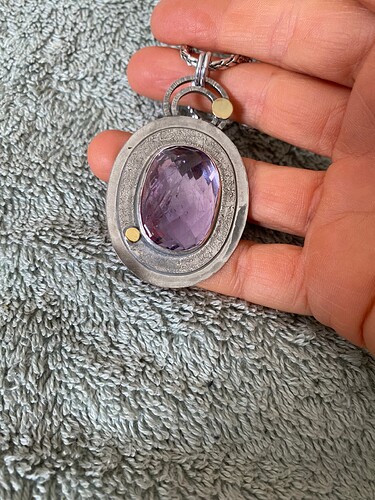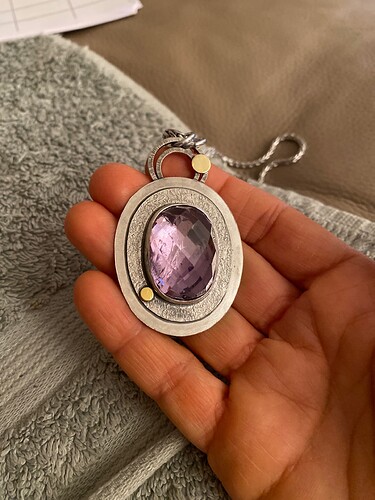Hello,
I’ve just set a big amethyst onto a patinated silver backplate. My problem is a dark spot on the side of the backplate (outer ring). I tried to rub but it doesn’t get shy better. Does anybody have an idea what I could do to remove it? Thank you very much!
Did you start with new metal or recycled metal?..Rob
Hi Rob!
I used new sterling silver.
I guess it’s a long fire stain although I was careful and used denatured alcohol at each soldering step. Probably the only solution would be to cover this area with some stamping…
I sanded the spot with a 3M disc (fine grit) and it disappeared! Might help someone. Got this tip on Facebook.
Glad that you figured it out. Recycled metal sometimes, at least in my experience, gets deep dark spots in it. New metal should just have been a very shallow spot that would buff or sand out. Do you have to recolor?..Rob
Hi Rob!
Maybe it’s recycled silver, who knows. Very interesting!
No I didn’t have to recolor, now apparently it’s ok.
Thank you very much too for your kind help!
I get dark spots sometimes in recycled metal. My assumption is that it might be flux or some impurity that got into the melt and not scale. Once I finish rolling or drawing an ingot, I usually finish it, especially sheet, so that I know what I have to work with and can avoid damaged areas that I can’t fix during finishing. It’s also just easier to polish larger flat pieces, depending on what you are doing with them, than smaller pieces. This is especially true of earrings. You still should use alcohol and boric acid as a barrier flux to avoid scale if you do further soldering operations. Good luck…Rob
It’s not the metal. It’s too dark for fire scale. I’ve never seen recycled metal do this. Did you use an oxidizer on the pendant?
Jo
Flux would not cause a discoloration.
I sometimes have a dark colored smear in my ingots after I roll them out. It is very dark. I can usually grind or sand them out, but sometimes they go all the way through. I have always just assumed it to be some of the borax flux that didn’t get completely removed. A good soak in plain water also helps. If anyone has an idea what it really is please let me know. I also get what look like air bubbles after rolling sheet to about 18 gauge. They appear after annealing. Thanks…Rob
I remember getting occasional dark patches on ingots (I did exclusively ceramic shell casting, not investment). Putting pickle mixed with hydrogen peroxide on these spots usually cleared them immediately, proving it was one of the copper oxides. Normally if it forms at all, it floats on the much denser liquid sterling and gets trapped by the flux, but on occasion I guess it can ‘escape’ (maybe too much turbulence on pouring?).
I also used to get air bubbles when rolling sheet, especially if casting fine silver (in which case it was almost certainly oxygen). No cure if extensive except remelt the sheet. Easily recognisable because of the smearing effect on the surface, often showed only after annealing which softened the surface enough. And by the fact that you could move them around with enough rolling 
Thank you very much everyone! Sorry I was away such a long time.
Happened again today - very dark spots. So before setting my stone I heated the spots with my torch and the spots disappeared. Put it quickly into the acid, water and then tumbled again - the patina is regular and there’s no spot left. Just in case it might help someone.

